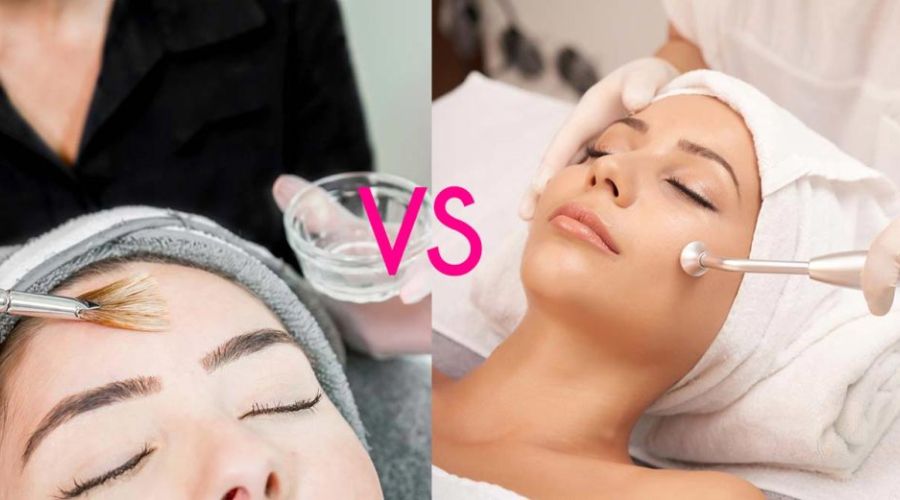Chemical Peels vs. Microdermabrasion: Which Treatment is Right for You?

Chemical Peels vs. Microdermabrasion: Which Treatment is Right for You?
When it comes to revitalizing your skin, chemical peels and microdermabrasion are two popular, effective treatments, but each offers unique benefits and outcomes. At UR Royalty Med Spa, we often guide clients in choosing the treatment that best suits their skin type and goals. Here’s a side-by-side comparison to help you understand these treatments and make an informed decision on your skincare journey.
What is a Chemical Peel?
A chemical peel is a skin-resurfacing treatment that uses a blend of acids to exfoliate and remove dead skin cells from the outer layer. Peels come in varying strengths, from light to deep, and can target specific skin concerns:
- Types of Chemical Peels: Light (superficial), medium, and deep.
- Common Ingredients: Glycolic acid, lactic acid, salicylic acid, and TCA (trichloroacetic acid).
- Key Benefits: Brightens dull skin, reduces fine lines and wrinkles, improves texture, and fades hyperpigmentation.
Who It’s For: Chemical peels are suitable for individuals looking to address concerns like sun damage, acne scars, uneven skin tone, and aging signs. Depending on the strength of the peel, they can be adjusted to suit sensitive or resilient skin.
What is Microdermabrasion?
Microdermabrasion is a physical exfoliation treatment that uses tiny crystals or a diamond-tipped device to gently exfoliate the skin’s outer layer. This process promotes cell turnover and helps to smooth and brighten the skin.
- Types of Microdermabrasion: Crystal microdermabrasion and diamond-tip microdermabrasion.
- Procedure: A gentle abrasion on the skin’s surface, followed by suction to remove debris.
- Key Benefits: Smooths rough texture, minimizes pore size, enhances radiance, and improves absorption of skincare products.
Who It’s For: Microdermabrasion is a great option for people with mild texture issues, minor pigmentation, or dull skin. It’s generally a milder treatment than chemical peels and can be used on sensitive skin types with minimal risk of irritation.
Comparing Chemical Peels and Microdermabrasion:
|
Feature |
Chemical Peel |
Microdermabrasion |
|
Depth of Exfoliation |
Light to deep, depending on peel strength |
Superficial |
|
Best For |
Sun damage, acne scars, fine lines, pigmentation |
Mild texture issues, dull skin, minor pigmentation |
|
Downtime |
Light peels: minimal to none; deep peels: up to 2 weeks |
Minimal to none |
|
Results Timeline |
Visible in days to weeks; improves with time |
Immediate radiance |
|
Frequency |
Every 4-6 weeks or seasonally |
Every 2-4 weeks, depending on skin type |
Pros and Cons of Chemical Peels
Pros:
- Offers targeted treatment for deeper skin concerns.
- Encourages cell turnover for smoother, firmer skin.
- Can address complex issues like pigmentation and deeper wrinkles.
Cons:
- Requires a bit more downtime, especially with medium and deep peels.
- Higher potential for temporary redness and peeling post-treatment.
Ideal Candidate: Clients looking for a powerful treatment to address aging, scars, and pigmentation may find chemical peels more effective.
Pros and Cons of Microdermabrasion
Pros:
- Non-invasive with no downtime.
- Provides an instant boost in radiance and smoothness.
- Safe for almost all skin types, including sensitive skin.
Cons:
- Doesn’t reach as deep as chemical peels, so results may be subtler.
- Needs more frequent treatments to maintain optimal results.
Ideal Candidate: Clients who prefer a gentler, quick-fix solution for dullness or slight texture issues would likely benefit from microdermabrasion.
Book Your Consultation at UR Royalty Med Spa
Still unsure which treatment is right for you? Our expert team at UR Royalty Med Spa can assess your skin’s needs and create a personalized treatment plan that brings out the best in your complexion. Schedule your consultation today and take the first step toward glowing, refreshed skin.

